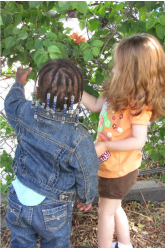 By Cheryl Ichikawa With each new child that enters our program comes a story. A story about who they are, where they came from and all their experiences, good and bad. As a teacher at Children Today, I understand that trauma is part of their story and that a child’s development may be delayed or altered due to stress, anxiety or fears associated with the experiences they have had in their life. In Dora’s blog post, Regression, she talks about how children can regress (returning to an earlier stage of behavior and physical development) from a traumatic event or prolonged exposure to stress or anxiety. She explains that “regression in children experiencing homelessness can be extreme and long-lasting.” Being mindful of this fact means that on any given day a child might need more support, more individualized attention or more space than usual. Building a trusting and unconditional relationship with these children allows us to support them and for them to feel safe even when they are grappling with their own emotions. As a teacher, observations are critical, not only in supporting children in their development, but in understanding their triggers. For some of our children, personal containment is a challenge which can create stress among the other children in the classroom. In the article, “Children and Trauma: The Role of Parents” written by Marsha L. Shelov, Ph.D., she highlights the fact that “mild or severe, a traumatically frightening event matters deeply to a child” and that even if parents choose to forget, “the child remembers.” She talks about the fact that the child needs to remember this life-changing event because it is a necessary part of the child’s healing process. She explains that in order for a child to heal, he or she must learn how to cope with the event and his or her feelings about what happened. This understanding is critical. Children act out for a reason. Some children act out due to boredom, a need for attention, a desire to test limits, hunger, exhaustion or their excitement in learning something new. However, other children act out for a much deeper reason that even they may not fully understand. We had a little girl that had the sweetest smile, but also a volatile temper. She could be handing a child a toy one moment and then turn around and bite that same child the next. She would often say, “Stop hurting me” or “You hurt me,” whether the teacher was setting a limit, changing her diaper, or laying her down for a nap. She also did not discriminate and said this to several teachers in a variety of situations. In every case, teachers would state to the child what they were doing or intended to do and would assure her that they were not hurting her. By prescribing to a philosophy of caring, understanding and positive reinforcement, our goal is to support all of our children in their physical, cognitive, social and emotional development. By providing children with opportunities to deal with conflict, and guidance in understanding their options, they learn how to manage their impulses. By allowing them to be more independent they learn to trust themselves and build their self-esteem. But most importantly, creating an environment that allows children who struggle with their emotions the opportunity to express their anger, sadness or frustration with the support of someone who cares, can be life-changing. The greatest gift that a caregiver (parent or teacher) gives to a child coping with trauma is seeing their sadness instead of simply responding to their behavior. It is allowing the child to express their emotions uninterrupted (within a zone of safety), yet always letting the child know that you are there to help them when they are ready. For a child to know that their feelings matter… that they matter… is powerful. Comments are closed.
|
AuthorVarious members of the Children Today staff contribute to these blog posts. Archives
July 2024
Categories |
